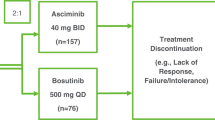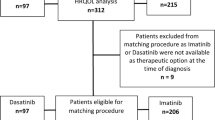Abstract
Health-related quality of life (HRQOL) is an important goal of therapy for chronic myeloid leukemia (CML) patients treated with current molecular-targeted therapies. The main objective of this study was to investigate factors associated with long-term HRQOL outcomes of CML patients receiving imatinib. Analysis was performed on 422 CML patients recruited in an observational multicenter study. HRQOL was assessed with the Medical Outcomes Study 36-Item Short-Form Health Survey (SF-36). Key socio-demographic and clinical data were investigated for their association with HRQOL outcomes. Chronic fatigue and social support were also investigated. Univariate and multivariate linear regression analyses were used to identify independent factors associated with HRQOL outcomes. Fatigue was the only variable showing an independent and consistent association across all physical and mental HRQOL outcomes (P<0.01). Differences between patients reporting low versus high fatigue levels were more than eight and seven times the magnitude of a clinically meaningful difference, respectively, for the role physical (Δ=70 points) and emotional scale (Δ=63 points) of the SF-36. Fatigue did not occur as an isolated symptom and was most highly correlated with musculoskeletal pain (r=0.511; P⩽0.001) and muscular cramps (r=0.448; P⩽0.001). Chronic fatigue is the major factor limiting HRQOL of CML patients receiving imatinib.
This is a preview of subscription content, access via your institution
Access options
Subscribe to this journal
Receive 12 print issues and online access
$259.00 per year
only $21.58 per issue
Buy this article
- Purchase on Springer Link
- Instant access to full article PDF
Prices may be subject to local taxes which are calculated during checkout


Similar content being viewed by others
References
Bjorkholm M, Ohm L, Eloranta S, Derolf A, Hultcrantz M, Sjoberg J et al. Success story of targeted therapy in chronic myeloid leukemia: a population-based study of patients diagnosed in Sweden from 1973 to 2008. J Clin Oncol 2011; 29: 2514–2520.
Kris MG, Benowitz SI, Adams S, Diller L, Ganz P, Kahlenberg MS et al. Clinical cancer advances 2010: annual report on progress against cancer from the American Society of Clinical Oncology. J Clin Oncol 2010; 28: 5327–5347.
Hochhaus A . Managing chronic myeloid leukemia as a chronic disease. American Society of Hematology Educational Program Book. Hematology 2011; 100: 128–135.
Gambacorti-Passerini C, Antolini L, Mahon F-X, Guilhot F, Deininger M, Fava C et al. Multicenter independent assessment of outcomes in chronic myeloid leukemia patients treated with imatinib. JNCI 2011; 103: 553–561.
Efficace F, Baccarani M, Breccia M, Alimena G, Rosti G, Cottone F et al. Health-related quality of life in chronic myeloid leukemia patients receiving long-term therapy with imatinib compared with the general population. Blood 2011; 17: 4554–4560.
Pinilla-Ibarz J, Cortes J, Mauro MJ . Intolerance to tyrosine kinase inhibitors in chronic myeloid leukemia: definitions and clinical implications. Cancer 2011; 117: 688–697.
Efficace F, Cocks K, Breccia M, Sprangers M, Meyers CA, Vignetti M et al. Time for a new era in the evaluation of targeted therapies for patients with chronic myeloid leukemia: inclusion of quality of life and other patient-reported outcomes. Crit Rev Oncol Hematol 2012; 81: 123–135.
Efficace F, Cardoni A, Cottone F, Vignetti M, Mandelli F . Tyrosine-kinase inhibitors and patient-reported outcomes in chronic myeloid leukemia: a systematic review. Leuk Res 2013; 37: 206–213.
Flechtner H, Bottomley A . Fatigue and quality of life: lessons from the real world. Oncologist 2003; 8: 5–9.
National Comprehensive Cancer Network (NCCN). Practice guidelines in oncology. Cancer-related fatigue, V.1.2012.
Coughlin SS . Surviving cancer or other serious illness: a review of individual and community resources. CA Cancer J Clin 2008; 58: 60–64.
Cicero V, Lo Coco G, Gullo S, Lo Verso G . The role of attachment dimensions and perceived social support in predicting adjustment to cancer. Psychooncology 2009; 18: 1045–1052.
Iacobucci I, Rosti G, Amabile M, Poerio A, Soverini S, Cilloni D et al. Comparison between patients with Philadelphia-positive chronic phase chronic myeloid leukemia who obtained a complete cytogenetic response within 1 year of imatinib therapy and those who achieved such a response after 12 months of treatment. J Clin Oncol 2006; 24: 454–459.
Zebrack B, Cella D . Evaluating quality of life in cancer survivors. In: Lipscomb J, Gotay C, Snyder C, eds. Outcomes assessment in cancer: measures, methods and applications. Cambridge University Press: Cambridge, UK, pp 241–263 2005.
Ware JE, Sherbourne CD . The MOS 36-item short-form health survey (SF-36). I. Conceptual framework and item selection. Med Care 30: 473–483.
Yellen SB, Cella DF, Webster K, Blendowski C, Kaplan E . Measuring fatigue and other anemia-related symptoms with the Functional Assessment of Cancer Therapy (FACT) measurement system. J Pain Symptom Manage 1997; 13: 63–74.
Cella D, Lai JS, Chang CH, Peterman A, Slavin M . Fatigue in cancer patients compared with fatigue in the general United States population. Cancer 2002; 94: 528–538.
Efficace F, Breccia M, Baccarani M, Alimena G, Lambertenghi Deliliers G, Specchia G et al. Development and feasibility of a patient-reported symptom checklist for chronic myeloid leukemia patients [abstract]. Haematologica 2010; 95: 189 Abstract 0465.
Zimet GD, Powell SS, Farley GK, Werkman S, Berkoff KA . Psychometric characteristics of the multidimensional scale of perceived social support. J Pers Assess 1990; 55: 610–617.
Apolone G, Mosconi P, Ware JE Questionario sullo stato di salute SF-36. Manuale d’uso e guida all’interpretazione dei risultati Versione Italiana Guerini e Associati Editore, Milan 1997.
Harrell FE Regression modeling strategies, with applications to linear models. Logistic Regression, and Survival Analysis Springer: New York, 2001.
Sauerbrei W . The use of resampling methods to simplify regression models in medical statistics. J R Stat Soci ser C (Appl Stat) 1999; 48: 313–329.
Efron B, Tibshirani R . An introduction to the bootstrap. Chapman and Hall: London, 1993.
Sloan J, Symonds T, Vargas-Chanes D, Fridley B . Practical guidelines for assessing the clinical significance of health-related quality of life changes within clinical trials. Drug Inf J 2011; 37: 23–31.
Cella D, Kallich J, McDermott A, Xu X . The longitudinal relationship of hemoglobin, fatigue and quality of life in anemic cancer patients: results from five randomized clinical trials. Ann Oncol 2004; 15: 979–986.
Alibhai SM, Leach M, Kowgier ME, Tomlinson GA, Brandwein JM, Minden MD . Fatigue in older adults with acute myeloid leukemia: predictors and associations with quality of life and functional status. Leukemia 2007; 21: 845–848.
Hahn EA, Glendenning GA, Sorensen MV, Hudgens SA, Druker BJ, Guilhot F et al. Quality of life in patients with newly diagnosed chronic phase chronic myeloid leukemia on imatinib versus interferon alfa plus low-dose cytarabine: results from the IRIS Study. J Clin Oncol 2003; 21: 2138–2146.
Ganz PA, Desmond KA, Leedham B, Rowland JH, Meyerowitz BE, Belin TR . Quality of life in long-term, disease-free survivors of breast cancer: a follow-up study. J Natl Cancer Inst 2002; 94: 39–49.
Lim JW, Zebrack B . Social networks and quality of life for long-term survivors of leukemia and lymphoma. Support Care Cancer 2006; 14: 185–192.
Nazha A, Williams L, Kantarjian H, Ault P, Garcia-Gonzalez A, Williams J et al. Fatigue in chronic myelogenous leukemia patients (pts) treated with tyrosine kinase inhibitors (TKI). Blood (ASH Annu Meet Abstr) 2011; 118, Abstract 3785.
Wantland DJ, Mullan JP, Holzemer WL, Portillo CJ, Bakken S, McGhee EM . Additive effects of numbness and muscle aches on fatigue occurrence in individuals with HIV/AIDS who are taking antiretroviral therapy. J Pain Symptom Manage 2011; 41: 469–477.
Minton O, Stone P . A systematic review of the scales used for the measurement of cancer-related fatigue (CRF). Ann Oncol 2009; 20: 17–25.
Acknowledgements
We are grateful to all patients who participated in this study and we acknowledge the essential contribution of the ‘Associazione Italiana contro le Leucemie, Linfomi e Mieloma (AIL)’, which provided logistic and administrative support to this project. This study was supported by Novartis. Novartis had no role in the design and conduct of the study; collection, management, analysis and interpretation of data; and preparation, review or approval of the manuscript.
Author contributions:
FE was the study co-ordinator and Mi Ba was the study co-coordinator of this project. Details of contribution are as follows: conception and design: FE, Mi Ba, FM; collection and assembly of data: FE, MB, GA, GR, GLD, CB, GS, R Di L, LL, DT, BM, FS, MD, Mi Ba, PL, MPS, LL, CF, DV, SS, AR; data analysis and interpretation: FE, FC, Mi Ba, FM; statistical analysis: FC, FE; manuscript writing: FE, FC, Mi Ba, FM; final approval of manuscript: FE, Mi Ba, MB, GA, GR, FC, LDG, CB, GS, RDL, LL, DT, BM, FS, MD, Mi Ba, PL, MPS, LL, CF, DV, SS, AR, MV, FM; provision of study material or patients: Mi Ba, MB, GA, GR, LDG, CB, GS, GF, LL, DT, BM, FS, MD, Mi Ba, PL, MPS, LL, CF, DV, SS, AR.
Author information
Authors and Affiliations
Corresponding author
Ethics declarations
Competing interests
Consultant or advisory role: FE, Mi Ba, MB, GR, CB (Novartis and Bristol Myers Squibb); research funding: FE, GR, PL (Novartis); honoraria: Mi Ba (Novartis, Bristol Myers Squibb, Pfizer and Ariad); expert testimony: DT (Novartis and Bristol Myers Squibb); AR (Novartis); other remuneration: DT (Novartis and Bristol Myers Squibb).
Additional information
Presented in part at the 54th Annual Meeting of the American Society of Hematology (ASH), 8–11 December 2012, Atlanta, GA, USA.
List of participants:
List of participants:
The following additional members of the Gruppo Italiano Malattie Ematologiche dell’Adulto (GIMEMA) Working Party on CML also participated in this study enrolling patients and collecting clinical data:
Petrini M (University of Pisa, Pisa, Italy);
Russo Rossi A (University of Bari, Bari, Italy);
Fioritoni G (Local Health Unit of Pescara, Hematology, Pescara, Italy);
Nobile F (‘Ospedali Riuniti’, Hematology, Reggio Calabria, Italy);
Di Raimondo F (Hospital ‘Ferrarotto’, Hematology, Catania, Italy);
Cuneo A (Arcispedale Sant'Anna’, Ferrara, Italy);
Gobbi M, Pierri I (University of Genova, clinica ematologica S Martino hospital, Genova, Italy);
Scortechini A (Hospital ‘Torrette’, Ancona, Italy);
Angelucci E (Struttura Complessa di Ematologia e Centro Trapianti. Ospedale Oncologico di Riferimento Regionale ‘Armando Busiinco’ Cagliari, Italy);
Peta A, (Azienda Ospedaliera Pugliese Ciaccio’, Hematology, Catanzaro, Italy);
Saglio G (University of Turin, Orbassano, Italy);
Pizzolo G (University of Verona, Verona, Italy);
Leone G (University of Rome ‘Cattolica S Cuore’, Department of Hematology, Rome, Italy);
Ferrari M (‘Ospedali Riuniti di Bergamo’, Hematology, Bergamo, Italy);
Longinotti M, Pardini S (University of Sassari, Hematology, Sassari, Italy);
Gherlinzoni F (Local Health Unit 9 of Treviso, Hematology, Treviso, Italy);
Zaccaria A (Hospital ‘Santa Maria delle Croci’, Hematology, Ravenna, Italy);
Fanin R, Tiribelli M, D’odorico C (University Hospital, Hematology, Udine, Italy);
Rossi G (Spedali civili Brescia, Brescia, Italy);
Ferrara F (Hospital ‘Antonio Cardarelli’, Napoli, Italy);
Lauria F (A.O. Universitaria Senese Pol. S. Maria alle Scotte—UOC di Ematologia e Trapianti, Siena, Italy).
Rights and permissions
About this article
Cite this article
Efficace, F., Baccarani, M., Breccia, M. et al. Chronic fatigue is the most important factor limiting health-related quality of life of chronic myeloid leukemia patients treated with imatinib. Leukemia 27, 1511–1519 (2013). https://doi.org/10.1038/leu.2013.51
Received:
Revised:
Accepted:
Published:
Issue Date:
DOI: https://doi.org/10.1038/leu.2013.51
Keywords
This article is cited by
-
Guidelines for the treatment of chronic myeloid leukemia from the NCCN and ELN: differences and similarities
International Journal of Hematology (2023)
-
Quality of life among chronic myeloid leukemia patients in the second-line treatment with nilotinib and influential factors
Quality of Life Research (2022)
-
Correlates of fatigue severity in patients with chronic myeloid leukemia treated with targeted therapy
Supportive Care in Cancer (2022)
-
Which triggers could support timely identification of primary antibody deficiency? A qualitative study using the patient perspective
Orphanet Journal of Rare Diseases (2021)
-
Associations between the gut microbiome and fatigue in cancer patients
Scientific Reports (2021)



